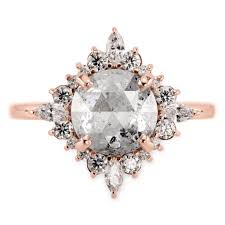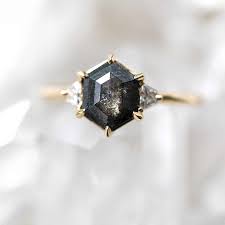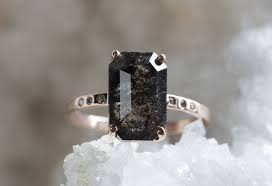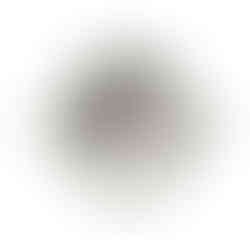Chocolate, Grey, Salt & Pepper, and Raw
- Wedding Day Diamonds

- Jan 15, 2019
- 5 min read

No, these aren’t names of sexy new restaurant openings. They’re actually the latest fads to touch the world of diamonds.
Here’s what you need to know if you’re considering using one of these trends in your engagement ring.
Let’s start with chocolate.

In a remote corner of northwest Australia there is a diamond mine. This mine is called Argyle, and in terms of volume, Argyle produces more diamonds than any other mine on Earth.

But Argyle has a problem: most of the diamonds it produces are not gemstone quality. In fact, 95% of Argyle’s diamonds are classified as industrial grade.
The remaining diamond crystals, though beautiful enough to be cut into gemstones, had another problem. Almost all of them were brown.
These brown stones were considered less desirable, and so in a master marketing move, brown was dubbed chocolate, and years later, brown diamonds are starting to have their day.
Here is what you need to know: Chocolate is a branding device.
All chocolate diamonds are brown diamonds, but not all brown diamonds are chocolate. This is because one company, Le Vian, has trademarked use of the term 'chocolate.' Other jewelers might call them cognac or champagne, depending on the hue.
All these names began as a way of turning something deemed undesirable into something special. (The old lemons to lemonade thing.)
But if a brown diamond is what you’re after, don’t pay more for a brand name.
Brown diamonds should be judged just like any normal white diamond… by the 4 C’s, and of those, primarily by the cut of the stone. A chocolate diamond by any other name can smell just as sweet.
It’s important to remember that these diamonds were, for a long time, undesirable. Therefore, they were cheaper than white diamonds.

Don’t be caught paying more for a fancy brown stone just because they’re trendy now.
They’re fairly abundant and should be priced accordingly. Like with any diamond, the size, cut and clarity should determine its cost… not the brand name. A large, clear, well cut champagne colored stone will cost. A poorly cut one shouldn’t, even if the color is unique.
Grey

Grey diamonds, if they are clear, are simply diamonds with a grayish hue, usually the result of hydrogen being present when the diamond was forming.
Natural grey diamonds with a high clarity score are very rare, much rarer than natural brown diamonds, so a truly clear grey diamond that is cut well may be hard to come by, and may cost what you would expect of any high quality fancy colored diamond, which is probably why a lot of “salt and pepper” diamonds are marketed as grey diamonds. Don’t be fooled. They’re not the same.
Salt and Pepper
Okay, here is where diamond sellers and designers have gotten really creative. Salt and Pepper diamonds are diamonds “peppered” with inclusions, or little white or black flecks and streaks throughout the stone. Unlike a grey diamond, where the entire stone will have an even grayish hue, salt and pepper diamonds will have noticeable clouds and deposits within the clearer parts of the stone.
While almost no diamond is internally flawless (almost all of them have some birthmarks), salt and pepper diamonds have loads of these inclusions, and therefore won’t sparkle like grey or brown diamonds will.
Instead, these diamonds tend to have a stormy, speckled appearance. Because salt and pepper diamonds won’t reflect and refract light the way diamonds ought to, they aren’t cut to the standards of other diamonds. Very often, you’ll see them in “rose cuts” where the entire bottom of the stone has been lopped off, flat across. Sometimes you’ll see just a few facets cut into the top to give it shape, but not dazzle.
And this is why salt and pepper diamonds, while cool for cocktail rings or fashion jewelry, are a risky choice for an engagement ring.

The 4 C’s don’t apply to salt and pepper diamonds, which means there really aren’t the same quality indicators for these stones that there are with other diamonds. This makes it really hard to know whether you’re paying a fair price for that diamond, or whether you’re being overcharged for a remedial stone in a “designer” mounting.
Compounding the risk is the fact that because the inclusion are so noticeable, no two salt and pepper diamonds will look alike. While that seems cool on the face of things, what does it mean in instances where something happens to your beloved stone?
In terms of insurance and warranty, it means the replacement you’ll be offered may be very, very different looking from the original stone that you loved. While that stone might have been speckled in a way that was really cool, your replacement may just be a poorly cut chunk of diamond with blobs of color in it.
In other words, the stone in Exhibit A (left) could be replaced with the stone in Exhibit B (right), and you'd be powerless to do anything about it. YIKES.
For this reason, we really think you should save the salt and pepper diamonds for statement jewelry, and choose only certifiably high quality diamonds for the ring you’ll wear everyday.
Raw

Raw diamonds are uncut, or barely cut diamond crystals. From a geological standpoint, they are definitely interesting to look at, but again, we’d caution you against choosing one for an engagement ring.

First, while a rough crystal may have some appeal, it’s the cutting that brings out the sparkle in a diamond, and that ability to sparkle like no other gemstone is one of the features that makes diamonds unique. With a rough crystal you’re giving up that very feature.

And secondly, the practicality of it is just too scary. For one thing, no two diamond crystals will be identical. Their shape will always be different from one to the next, and that means when your raw diamond is mounted, it’s the first time a stone exactly that shape has ever been mounted in that way. In other words, it’s not tried and true.
Traditional diamond cuts, from round to marquise and everything in between, have been mounted in various ways millions of times over.
In other words, jewelers have it down. They know the risks of tension mountings compared to bezel settings, and they know the physics of both.
They know exactly how to position the diamond for optimum appearance, but also for optimum durability. There is simply no way to emulate this experience with a raw diamond crystal.

In fact, they may not even know if your raw crystal has a fault line running through it, and if it does, and that stone is banged against a doorway or countertop at just the right angle, your one large crystal could quickly splinter into two or more smaller stones, which may or may not be secured by that pricey designer mounting.
So again, while these raw crystals are cool, save them for occasional pieces… a statement necklace, for example, and go with tried and true diamonds for your engagement ring.
Your engagement ring should endure every single thing yet to befall you. Don’t compromise that sort of structural integrity on a passing trend.













Comments